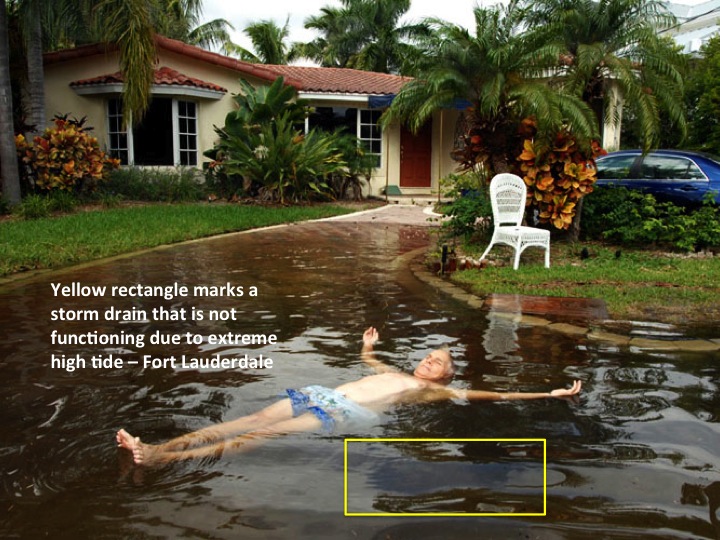When will we see effects of SLR? – Car wheels are already rusting

Here are some current accounts from South Florida, though similar stories are happening in coastal communities all over the world.
In low lying areas saltwater is pooling at high tide each month during the full moon when the tide cycle is exaggerated. A few times a year, during the extreme tides, when the planets line up, the effect is even more exaggerated — the next one of those will be in October. Slowly rising sea level rise is lifting the normal range of tides ever higher, bringing the highest tides onto streets.
In Key West this means that the the storm drains that were designed to take street runoff to the sea now work in reverse several days a month. It also happens in parts of Fort Lauderdale, Pompano Beach, Briney Breezes, Stirling Village, and the list goes on. In Miami Beach, routine flooding at lunar high tide is happening at numerous locations, for example: South Alton Road at the MacArthur Causeway, parts of Collins Avenue, and areas either side of Lincoln Road and more. Wheels on cars are rusting from the saltwater.
It is worse during severe rains when the water cannot run off into the stormwater system due to higher sea level and the ground is saturated. But even without the flood from rains, these areas see rising salt water pooling at extreme tides. In places like Florida and coral based islands, the ground is porous limestone, meaning that water just flows through the rock, regardless of seawalls.
While some residents are able to notice that these things did not happen thirty years ago, most have not noticed since the change is so gradual. It is like that proverbial account of boiling the frog. Allegedly if you put a frog in water and slowly raise the heat, it will not notice and will boil to death, as opposed to dropping him in very hot water, when it would jump out. [See Note below for the biology experiment discrediting that tale, but avoid it if dissecting a frog makes you squeamish.] The truth is that we can already see the effects of rising sea level if we just open our eyes, though it is hard to discern for a few reasons.
- One has to appreciate tidal variations to correlate the intermittent flooding.
- The amounts are more significant during major rainfall events, when the ground is saturated, which of course obscures the underlying issue about SLR.
- While storms, extreme tides, and sea level rise all combine for effect, in the present era, storms are the big event — think “Sandy” — which distracts from the long term inexorable SLR, though that will start to change over the coming century as sea level just keeps getting higher and higher.
So the next time you hear someone say that we don’t need to worry about sea level rise, that our kids and grandkids will have to worry about that, see if their eyes are closed, or if they have their hands over their eyes — no peeking.
Sea level will continue to rise as long as the ice sheets in Greenland and Antarctica keep melting. They will keep melting as long as global temperature stays higher than the average for the last century. That will happen as long as CO2 levels stay above 350 ppm (parts per million). As shown on the CO2 Now graphic on my home page, it is approaching 400 ppm, continuing the consistent climb of the last century.
As readers of my book know, I believe we need to adapt to higher sea level as this is one problem that is here to stay. In addition to intelligent adaptation, we should try to slow the warming as quickly as possible.
If you find this information helpful, please share with friends, colleagues, and your social networks.
—————–
NOTE ABOUT BOILING THE FROG. In fact, students in a biology class decided to test this oft-repeated tale. It turns out not to be quite true. A frog will jump out of warming water. Taking the experiment one step further, during dissection lab work they did put a frog in the water after its brain had been removed. Though it still had muscle action, it did not jump out of the warming water. This led one observer to say that our response to the slow process of climate change is similar to that of a frog without a brain.
